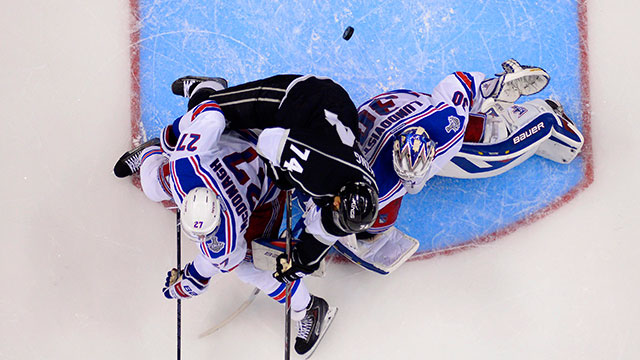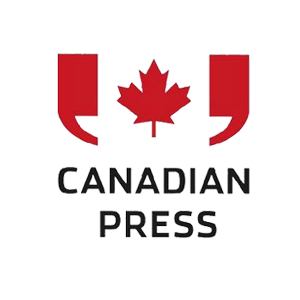NEW YORK — As the NHL eyes expanded video review, it’s unlikely to solve problems with goaltender interference.
The league’s competition committee met Monday, two days after a controversial goal in Game 2 of the Stanley Cup final that involved contact on Rangers goalie Henrik Lundqvist, and discussed making more situations subject to review. But because of the variables present, there’s no comfort level about making goaltender interference reviewable.
"I think the underlying fundamental here is that if you’re going to go to video review in a given area, there is the expectation of certainty," said Mathieu Schneider, the NHLPA’s special assistant to the executive director. "And it’s just not there. It’s very difficult. The type of things that we’re talking about, a possible coach’s challenge, are things that we might be able to be certain on. But there’s still a ton of grey area."
The Kings’ goal Saturday night that helped them build a 2-0 series lead was not the reason goaltender interference came up at the annual meeting, but it’s certainly a hotter topic because of it. The league’s general managers will discuss it Wednesday as well, but executive vice president and director of hockey operations Colin Campbell expects there to be more education on the subject in lieu of video review.
"Education that’s meant for our players and our referees regarding how to call goaltender interference in various situations, so to be more defined in that area — if it doesn’t take another step, meaning some sort of video review on it," Campbell said.
Nothing was resolved in terms of defining what video review could include next season, something that the GMs could try to hash out later this week. There are many possibilities.
"We talked about pucks over the glass, we talked about offside goals," Campbell said. "Then, it comes to the question if it’s an offside play: how much time? Is it five seconds? Is it 10 seconds? Change of possession? On the rush? Puck leaving the zone? What if a minor occurs during that time and a goal was scored but the play was offside? Does the minor come down? Does a double-minor come down? Does a major come down?"
A coach’s challenge system could be part of that process, requiring a timeout to use one. But coaches would not be able to request a review on goaltender interference.
The competition committee made some more solid recommendations on rule changes that GMs discussed at their March meeting in Boca Raton, Fla., most of which are designed to create more goals, including a more lenient interpretation of kicked-in goals and moving the faceoff-circle hashmarks back from 3 1/2 to 5 feet to give offensive teams more room to operate.
"There’s a feeling that, again, this can create more offence, that forwards on a won draw in the offensive zone will have more time to make plays, more room to make plays off winning draws," Schneider said. "And then on the flip side, it’s going to reduce the amount of scrums that we have off faceoffs separating those two players a little bit more."
If approved by the GMs, board of governors and NHLPA executive committee like all of these changes must be in order to go into effect, on icing calls, the offending team won’t be able to replace the original player taking the faceoff as a way of delaying. One violation would bring a warning and second would bring a minor penalty.
Small overtime adjustments also got the green light from the group, which included GMs Ken Holland of the Detroit Red Wings, David Poile of the Nashville Predators, Don Maloney of the Phoenix Coyotes and Peter Chiarelli of the Boston Bruins, Philadelphia Flyers chairman Ed Snider and players Ron Hainsey, Kevin Shattenkirk, Daniel Winnik, Michel Cammalleri and Cory Schneider. Teams will change ends and the ice will get a dry scrape before the five-minute overtime in the regular season.
The goal is to have more games decided in overtime and fewer in shootouts, with the long change like the second period representing the first step.
"Historically in our league, more goals are scored in the second period than the first and third, and we’re hoping the long change would affect in a positive way goal scoring so we change ends in overtime now in the playoffs, so we thought why not," Campbell said. "We thought that was a silly reason to not change ends."
One new recommendation is to make the trapezoid behind the nets four feet bigger to give goaltenders more room to handle the puck. Schneider has pointed to the safety of defencemen as the reason.
"We’ve been talking about the trapezoid for a couple of years now, and the idea of either eliminating the trapezoid or expanding it to give more relief to defencemen going back to retrieve pucks," Scheider said. "Goalies would have better opportunity to get their defencemen out of danger zones."
And while there wasn’t much of a consensus about video review, embellishment seems to be a different story. The next step is figuring out how to solve the issue.
"We feel embellishment in the game is a real problem today," Campbell said. "We understand players try to draw penalties. We feel it’s out of control, and we’ve discussed another approach at embellishment, similar to the rule that’s already in the rule book. But there would not be a game suspension attached to that, there would be a warning and fines."
That could include fining coaches and organizations along with players, Campbell added.
While that could help curb one problem that has been part of these playoffs, goalie interference remains an almost unsolvable issue. Even the Game 2 situation brought what Schneider called a "split room" on whether it should have counted or not.
"There’s a lot of instances where you have two reasonable people looking at the same video and have two different interpretations, and goalie interference is certainly one of those," Schneider said. "I think the education process is what’s going to be most important for the officials, for the players, and I think Colin alluded to, we want to maybe err on the side of the goalie more often. Well, that’s the direction we have to give to the officials.
"The education process is going to be key. And to have certain telltale signs."









